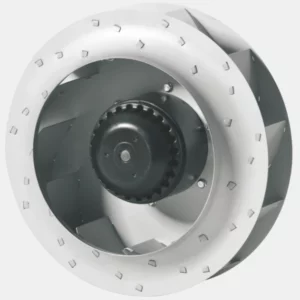Backward curved centrifugal fans are widely used in various applications where high-efficiency air movement is required. These fans are characterized by their unique blade design, which curves backward against the direction of rotation.
Here are some common uses of backward curved centrifugal fans:
- HVAC Systems: Backward curved centrifugal fans are extensively used in heating, ventilation, and air conditioning (HVAC) systems. They are employed in air handling units (AHUs), rooftop units, and ducted systems to provide efficient air circulation and maintain comfortable indoor environments.
- Cleanroom Environments: Backward curved centrifugal fans are suitable for cleanroom applications that demand high air quality and cleanliness. They are used in industries such as pharmaceuticals, electronics manufacturing, semiconductor fabrication, and biotechnology, where strict control of airborne particles is essential.
- Energy Recovery Ventilation (ERV): Backward curved centrifugal fans play a crucial role in energy recovery ventilation systems. These systems exchange heat or energy between the incoming and outgoing air streams, improving energy efficiency and reducing heating or cooling costs in commercial buildings.
- Industrial Ventilation: Backward curved centrifugal fans are employed in industrial ventilation systems to remove airborne contaminants, fumes, or dust from the working environment. They are utilized in manufacturing facilities, warehouses, chemical plants, and other industrial settings to maintain air quality and ensure a safe working environment.
- Air Purification and Filtration: Backward curved centrifugal fans are used in air purification systems, including air purifiers and filtration units. They assist in drawing air through filters, removing particulates, allergens, and pollutants to improve indoor air quality in residential, commercial, and healthcare settings.
- Data Centers: Backward curved centrifugal fans are employed in cooling systems for data centers and server rooms. These fans help dissipate heat generated by servers, ensuring proper cooling and preventing overheating that could impact the performance and lifespan of critical IT equipment.
- Laboratory Fume Hoods: Backward curved centrifugal fans are utilized in laboratory fume hoods to exhaust hazardous fumes and chemicals. They ensure the effective capture and removal of harmful substances, protecting laboratory personnel and maintaining a safe working environment.
- Commercial Kitchens: Backward curved centrifugal fans are used in commercial kitchen exhaust systems to remove smoke, grease, and odors generated during cooking. They ensure proper ventilation and air quality in restaurant kitchens and food preparation areas.
Backward curved centrifugal fans are valued for their high efficiency, low noise levels, and ability to handle moderate to high-pressure applications. It’s important to consult with experts or fan manufacturers to select the appropriate fan size and configuration for the specific application requirements.
How does the backward curved centrifugal fan work?
The backward curved centrifugal fan operates based on the principles of centrifugal force and aerodynamics. It uses a curved blade design that curves backward against the direction of rotation.
Here’s how a backward curved centrifugal fan works:
- Air Intake: The fan draws in ambient air through its inlet. The shape of the inlet and housing is designed to guide the air into the fan.
- Impeller Design: The impeller of a backward curved centrifugal fan consists of curved blades that curve backward from the direction of rotation. These blades are typically wider at the base and gradually taper towards the outer edge. The backward curve design helps increase the efficiency of the fan.
- Centrifugal Force: As the impeller rotates, the backward curved blades exert centrifugal force on the air. This centrifugal force causes the air to move radially outward from the center of the impeller.
- Air Acceleration: The backward curved blades accelerate the air as it moves radially outward. This acceleration increases the kinetic energy of the air, converting rotational energy from the impeller into airflow.
- Air Discharge: The accelerated air is discharged into the fan housing in a direction perpendicular to the axis of rotation. The housing is designed to guide the airflow and direct it towards the desired outlet or ventilation system.
- Pressure Development: The curved blades of the impeller create a pressure gradient within the fan housing. As the air moves from the center to the outer edge of the impeller, the pressure increases. This pressure development helps generate the required airflow and overcome system resistance.
- Efficiency and Noise Reduction: The backward curved blade design of the impeller offers several benefits. It provides high efficiency by reducing air turbulence and pressure losses. The curved shape also helps reduce noise levels compared to other fan designs, making backward curved centrifugal fans suitable for applications that require low-noise operation.
- Motor Drive: The backward curved centrifugal fan is typically driven by an electric motor. The motor is connected to the impeller either directly or via a belt and pulley system, depending on the fan configuration.
Overall, the backward curved centrifugal fan design allows for efficient and effective air movement. It generates a high volume of airflow at relatively high pressures, making it suitable for applications that require moderate to high pressure capabilities, such as HVAC systems, cleanrooms, industrial ventilation, and air purification systems.
